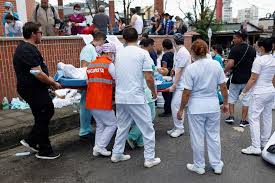A substantial seismic event measuring 6.3 in magnitude jolted Colombia's densely populated capital city on Sunday morning, triggering widespread evacuations as buildings swayed violently across Bogotá. The tremor occurred near Paratebueno, approximately 170 kilometers east of the capital, according to the United States Geological Survey.
Contrasting assessments emerged regarding the earthquake's intensity. While the USGS recorded it as a 6.3-magnitude event, Colombia's own Geological Service registered a stronger reading of 6.5 on the Richter scale. The discrepancy highlights variations in measurement methodologies between international and national seismic monitoring agencies.
Chaos in the Capital
Residents experienced several intense minutes of shaking shortly after 8:00 a.m. local time. The sudden movement sent office workers and families scrambling from structures as emergency sirens echoed throughout the city. Eyewitness accounts described scenes of confusion with people gathering nervously in parks and open spaces, some still wearing sleepwear.
"The shaking felt incredibly forceful—I had to carefully navigate multiple staircases to get outside," recounted one elderly resident to journalists at the scene.
Verifiable social media footage showed streams of citizens evacuating commercial buildings and residential complexes. One verified video from BluRadio Colombia documented crowds assembling in Bogotá's streets moments after the ground stopped moving, with parents comforting distressed children and individuals searching for pets that fled during the disturbance.
Official Response and Infrastructure Impact
Bogotá Mayor Carlos Galán provided initial assessments via social media, noting thankfully that no serious injuries resulted directly from the quake. "Emergency services attended to one individual experiencing severe anxiety, who was transported to Central Hospital," Galán stated. "We've received reports of minor structural damage and brief power interruptions, though electricity has since been restored to affected sectors."
Civil defense teams immediately deployed to inspect bridges, roads, and critical infrastructure throughout the metropolitan region. Initial evaluations suggested most damage remained cosmetic, such as fallen ceiling tiles and cracked non-load-bearing walls, though comprehensive structural assessments continue.
Regional Seismic Vulnerability
Central Colombia sits within the Pacific Ring of Fire, making it highly susceptible to tectonic activity. The region has endured devastating earthquakes historically, including a catastrophic 1999 tremor that claimed nearly 1,200 lives. This geological reality necessitates stringent building codes throughout Bogotá, which likely contributed to preventing major structural failures during this event.
Seismologists emphasize that while Sunday's quake produced significant shaking, its relatively deep focus point and distance from urban centers mitigated potential destruction. Authorities continue monitoring aftershocks, urging citizens to maintain emergency preparedness kits and family communication plans, as Colombia's complex network of fault lines remains persistently active.
Source: Verified reports from international geological agencies and Colombian emergency services.








Comments (0)
Leave a Comment
Be the first to comment on this article!